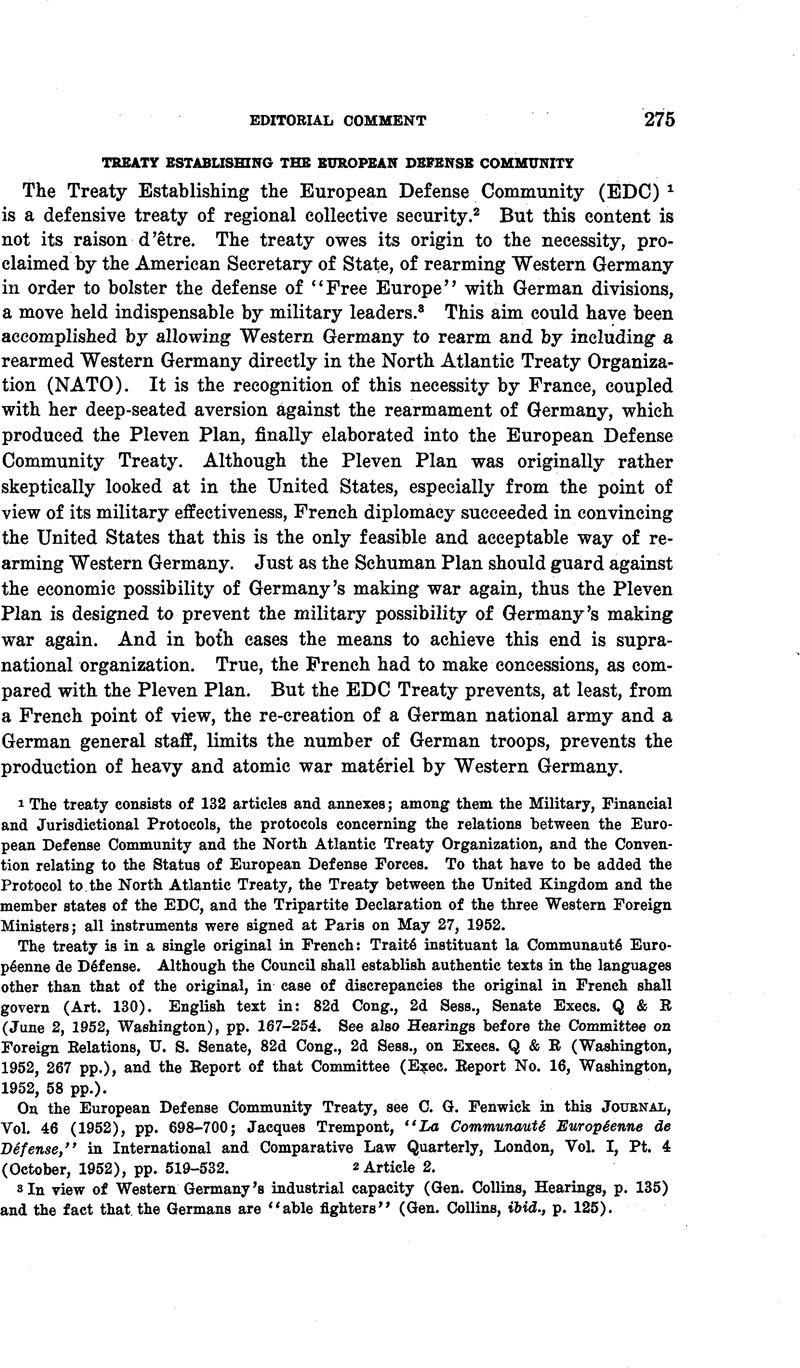Article contents
Treaty Establishing the European Defense Community
Published online by Cambridge University Press: 20 April 2017
Abstract

- Type
- Editorial Comment
- Information
- Copyright
- Copyright © American Society of International Law 1953
References
1 The treaty consists of 132 articles and annexes; among them the Military, Financial and Jurisdictional Protocols, the protocols concerning the relations between the European Defense Community and the North Atlantic Treaty Organization, and the Convention relating to the Status of European Defense Forces. To that have to be added the Protocol to the North Atlantic Treaty, the Treaty between the United Kingdom and the member states of the EDC, and the Tripartite Declaration of the three Western Foreign Ministers; all instruments were signed at Paris on May 27, 1952.
The treaty is in a single original in French: Traité instituant la Communauté Euro-péenne de Défense. Although the Council shall establish authentic texts in the languages other than that of the original, in case of discrepancies the original in French shall govern (Art. 130). English text in: 82d Cong., 2d Sess., Senate Execs. Q & R (June 2, 1952, Washington), pp. 167–254. See also Hearings before the Committee on Foreign Relations, U. S. Senate, 82d Cong., 2d Sess., on Execs. Q & R (Washington, 1952, 267 pp.), and the Report of that Committee (Exec. Report No. 16, Washington, 1952, 58 pp.).
On the European Defense Community Treaty, see C. G. Fenwick in this Journal, Vol. 46 (1952), pp. 698–700; Jacques Trempont, “La Communauté Européenne de Défense,” in International and Comparative Law Quarterly, London, Vol. I, Pt. 4 (October, 1952), pp. 519–532.
2 Article 2.
3 In view of Western Germany’s industrial capacity (Gen. Collins, Hearings, p. 135) and the fact that the Germans are “able fighters” (Gen. Collins, ibid., p. 125).
4 It plays a dominant rôle in the related “Financial Convention” with Bonn; its coming into force is an indispensable condition for the coming into force of the agreements with Bonn.
5 European Defense Community Treaty, Art. 5. Secretary of State, in Hearings, p. 22.
6 Treaty, Art. 18.
7 Ibid., Arts. 13, 47, 68, 69, 70, 77, 78 bis, 91, 94, 101, 102, 128.
8 Ibid., Art. 128; European Coal and Steel Treaty, Art. 97.
9 Arts. 7 and 6, respectively.
10 Arts. 116 and 76, respectively.
11 Arts. 129 and 98, respectively. But as the “accession” is conditional upon the unanimous vote of the Council, the system is, in fact, not one of accession, but of admission.
12 Already the Preamble speaks of a “supra-national organization” and of the “formation of a United Europe,” whereas the Preamble of the Coal and Steel Treaty speaks only of “an organized and vital Europe.” The supra-national character is also strongly underlined in Arts. 1 and 20, par. 2.
13 European Defense Community Treaty, Art. 9.
14 Art. 10, pars. 1, 4. But “The total volume of national armed forces … shall not be so great as to compromise participation of each member State in the European Defense Forces” (Art. 10, par. 5). Art. 13, particularly attacked in France in view of the Indo-China war, makes the withdrawal of troops from the European Defense Forces in case of a serious emergency affecting a non-European territory dependent on the agreement of the Supreme NATO Commander.
15 European Defense Community Treaty, Arts. 9–18, 68–79, and Military Protocol.
16 Ibid., Art. 80.
17 Military Protocol, Art. 16.
18 Ibid., Art. 17.
19 European Defense Community Treaty, Art. 80.
20 Ibid., Arts. 33–38.
21 Ibid., Art. 87, par. 3.
22 Ibid., Arts. 51–67.
23 Ibid., Arts. 19–31.
24 E.g., recruitment of basic units (Art. 73); decision to proceed with mobilization (Art. 75).
25 Thus as to the single general regulations concerning military discipline of the European Defense Forces (Art. 79).
26 Treaty, Arts. 39–50.
27 “Unless otherwise provided in the present treaty” (Art. 39, par. 4).
28 Thus, under Arts. 20, par. 1; 23; 31; 39, par. 1; 44; 48; 68, par. 2; 77, par. 1; 105; 123, par. 1; 129.
29 Art. 71.
30 Art. 74; Military Protocol, Art. 26.
31 Art. 78.
32 Art. 72, par. 2.
33 European Defense Community Treaty, Arts. 83–100 and Financial Protocol.
34 Such qualified majority must in all cases, where required, include the votes of the representatives of the member states which together placed at the disposal of the Community at least two-thirds of the total contributions of the member states, or the votes of five member states (Art. 43, par. 2).
35 Treaty, Arts. 101–111.
36 To aid the Commissariat in this task a Consultative Committee shall be established (Art. 109).
37 E.g., later direct recruitment by the Commissariat (Art. 73, par. 3).
38 Treaty, Art. 8; see also Art. 75, par. 2.
39 Socialist opposition, the constitutional issue, anti-rearmament sentiment, fear of adverse economic repercussions and of the reaction of the Soviet Union, fear of definitely blocking the unification of the “two Germanies,” irritation over the Saar issue, recent political developments in France, slowing down of NATO efforts.
40 Basically fear of Germany, worry about the Indo-China war, considerations of national sovereignty, economic difficulties, lessening of the fear of Soviet aggression in Europe, wish to have first a definitive settlement of the Saar problem in favor of France, more American aid, closer association of the United Kingdom with the European Defense Community, dissatisfaction with certain clauses of the treaty (e.g., Art. 13).
41 Cf. M. J. Bonn, Whither Europe? Union or Partnership? (New York, 1952).
- 5
- Cited by




